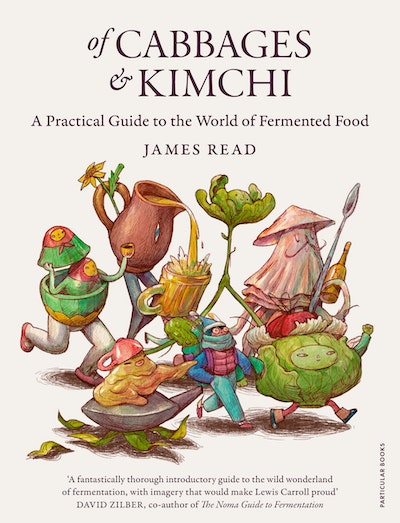Fermentation fun with kimchi.
Chinese leaf heads vary enormously – they can weigh up to 2kg, or as little as 500g (but puzzlingly they’re priced by piece not weight). They can be dense and compact or light and leafy, and anything from ivory-coloured to pine-green. For kimchi, I’d usually opt for the dense, heavyweight, paler variety – but you’ll find these much more easily between the months of October and March. I’ve yet to meet a specimen that can’t be fermented successfully, though, so go with what you can get.
Time: 3-9 days (depending on ambient temperature)
Makes: 2kg kimchi
INGREDIENTS
Day one
- 1 bunch of spring onions (~150g)
- 250g carrots, peeled
- 2 heads of Chinese leaf (~2kg)
- 120g coarse sea salt
Day two
- 5cm ginger, peeled and roughly chopped
- 10 cloves of garlic, peeled
- 95g doenjang or aka miso or 40g preserved shrimp (saeujeot)
- 10g caster sugar
- 60g gochugaru chilli flakes
METHOD
- Chop the spring onions into 5cm lengths and separate whites from greens. Put the greens in a large bowl, and the whites aside in the fridge for making sauce the next day.
- Chop the carrots into 5cm batons about the thickness of a pencil and add to the onion greens.
- Remove any damaged outer leaves plus the bases from the cabbage and discard (retaining a large outer leaf as a weight, if desired). Chop the cabbage into 5cm-wide strips and combine with the carrots and spring onion greens.
- Combine the salt with the chopped veg, mix thoroughly and leave covered overnight. The veg will shrink and wilt substantially as water is drawn out of it.
- The next day, thoroughly rinse the salted veg twice.
- Combine the ginger, garlic, miso, sugar and gochugaru in a food processor, and pulse until you have a paste a little looser than peanut butter. You may need to add a little water.
- Combine the chilli paste with the rinsed veg (rubber gloves are advised), getting it between every leaf.
- Once thoroughly mixed, put the kimchi in your jar, and cover with weights – as the cabbage releases brine this will keep everything submerged. Make sure there’s a little headspace at the top of your container (5–10cm). Seal, and leave in a cool place if you can – around 10–15°C is ideal – and out of direct sunlight.
- Check your kimchi daily for signs of fermentation (bubbling and a change in smell – you might notice a ‘pear drop’ aroma) and continue to open the jar twice a day to let gas escape once it has begun fermenting. Watch out, if it’s particularly fizzy it might try to escape the jar – wrapping a piece of kitchen roll over the lid as you open it will save your clothes and worktop from kimchi spatter.
- Three to five days after fermentation has begun, your kimchi should be ready – it’ll be quicker if you’ve put it somewhere warmer. Try it, and if it tastes good, refrigerate. If it still tastes a bit raw, leave it for another day. Once in the fridge, it will keep for well over a month, but loosen the lid every few days to prevent gas build-up.














